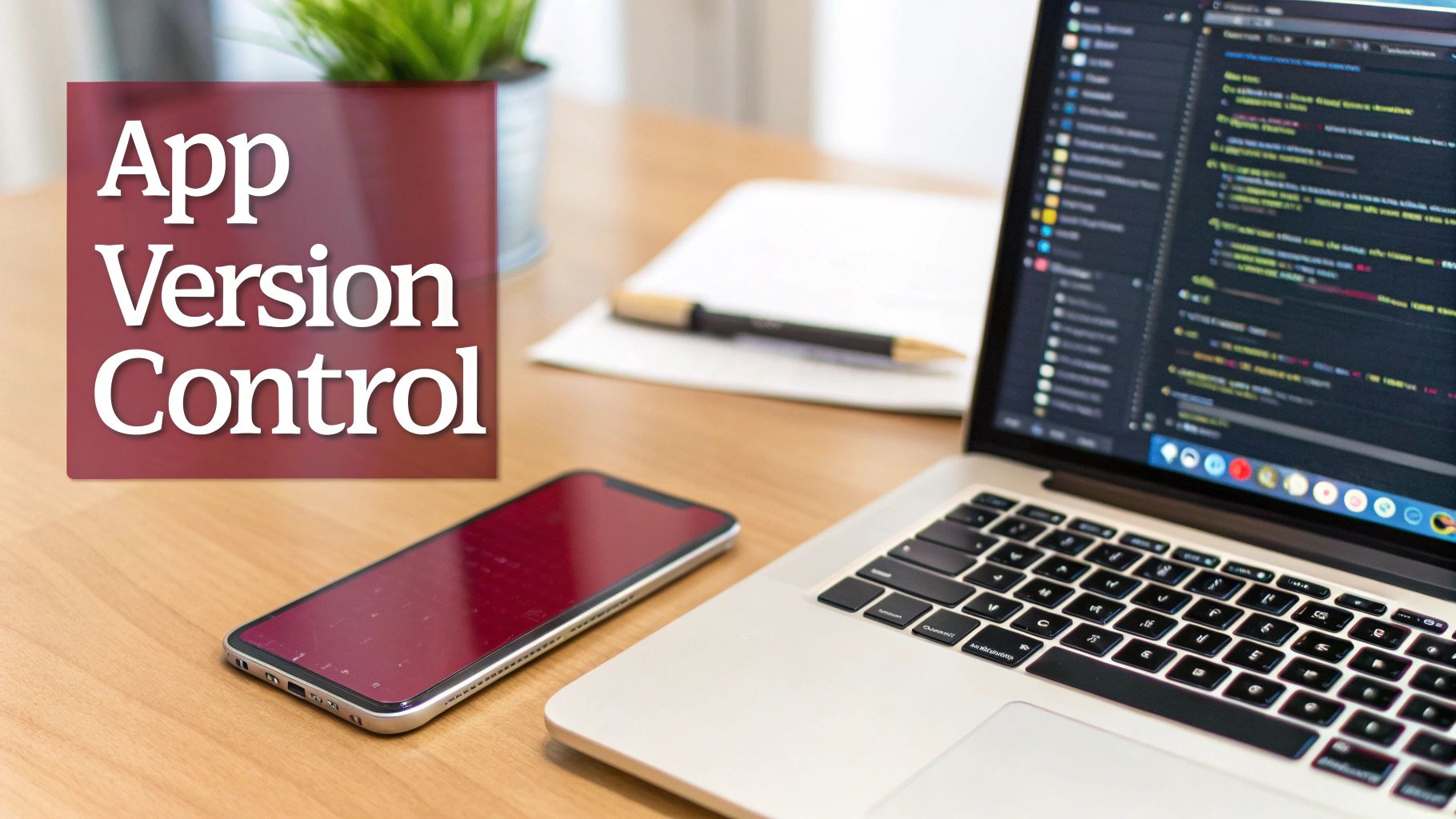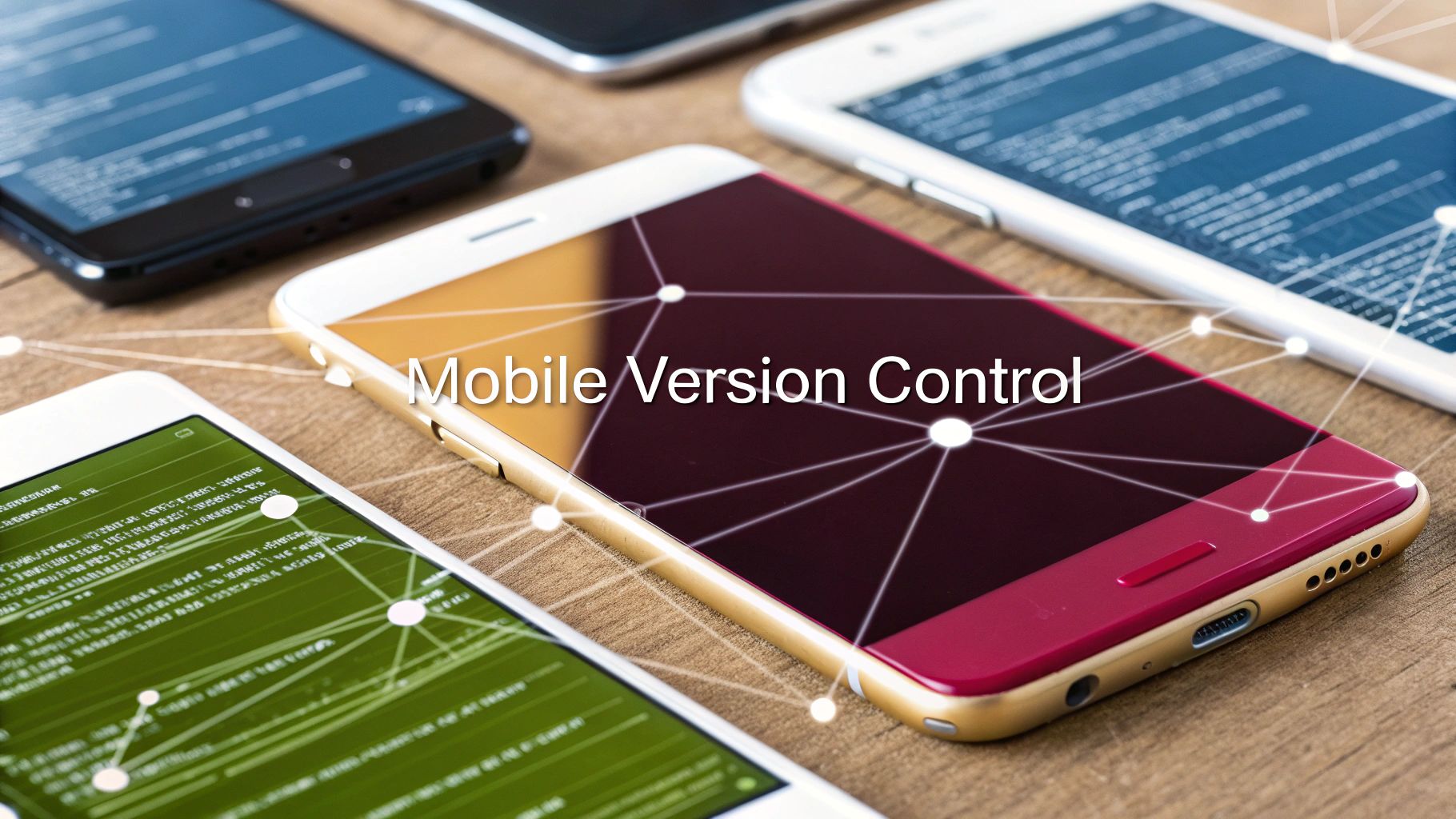When you’re deep in the trenches of app development, it’s easy to get lost in the code. Mobile app version control is your map and compass—it’s the disciplined practice of tracking and managing every change to your app’s source code, assets, and even its release history.
Think of it as a meticulously kept diary for your application. Every entry, every change, is recorded, making the entire development process transparent, traceable, and, most importantly, stable for your users.
Why Version Control Is Not an Option

In a market this crowded, launching and updating an app without a solid version control system is like trying to navigate a maze blindfolded. It’s more than just risky; it’s a recipe for chaos. Proper mobile app version control isn’t some technical footnote for developers. It’s a cornerstone of your business strategy that directly shapes user satisfaction, your bottom line, and how people see your brand.
What happens when you ignore it? The fallout can be brutal. One buggy update can unleash a torrent of one-star reviews, send users flocking to your competitors, and cause a painful financial hit. And when you need to roll back to a previously stable version? Without a clear history, it’s a high-stakes, frantic scramble that’s almost guaranteed to introduce even more errors.
The Foundation of Stability and Trust
A well-oiled version control system brings order to the beautiful chaos of modern app development. It creates a space where your team can build exciting new features in parallel without ever jeopardizing the stable, live version of your app. This kind of organized workflow is crucial for tackling the two biggest headaches in the mobile world:
- Rapid Release Cycles: Your users want new features and improvements—and they want them yesterday. Version control helps you deliver those updates quickly and confidently.
- Device and OS Fragmentation: Your app needs to work flawlessly on countless devices and operating systems. A disciplined versioning strategy is the only way to ensure a consistent, high-quality experience for everyone.
By treating version control as a strategic pillar, you transform it from a background task into a competitive advantage. It’s the framework that supports every successful feature launch, bug fix, and user-facing update.
This structured approach is more critical now than ever. The mobile world is growing at an incredible pace, with global app downloads expected to reach a staggering 299 billion in 2025, up from 257 billion in 2023. With the average person using around 10 apps every single day, rock-solid stability is your ticket to staying in the game. You can explore more mobile app download trends to really grasp the scale of the opportunity.
Real-World Impact on Your Business
At the end of the day, sloppy versioning creates real business problems. Haphazard rollbacks burn through precious developer hours, frustrated users tank your App Store ratings, and a reputation for being unreliable can tarnish your brand for good. In a market where a competitor is just a tap away, stability isn’t a “nice-to-have”—it’s everything. Getting mobile app version control right is the first step toward building an app that people trust and a brand that lasts.
Understanding the Foundations of Version Control

To really get a handle on mobile app version control, you need to go beyond just memorizing commands. It’s about understanding why these systems exist in the first place. Think of a Version Control System (VCS) as both a safety net and a time machine for your project’s code. It’s the framework that lets your team build things together without the constant fear of overwriting someone else’s work or losing a week of progress to a single mistake.
Let’s break down the core ideas with an analogy I’ve always found helpful. Imagine your app’s entire codebase is a massive, complex blueprint for a skyscraper.
-
The repository (or repo) is the master blueprint stored safely in the main office. It represents the official, current state of the entire project—the single source of truth.
-
A commit is like an engineer submitting an approved change. When they finalize a design for the electrical wiring on the 10th floor, they “commit” it to the master blueprint. This action creates a permanent snapshot, along with a note explaining the change, like, “Finalized 10th-floor electrical layout.”
-
A branch is a copy of the blueprint taken to a separate drafting table to test out a new idea. Maybe an architect wants to experiment with a different lobby design without messing up the master plan. They create a branch to work on this new concept in isolation. If the project manager approves, the new lobby design can be merged back into the master blueprint. If not, the copy is simply thrown away, and the original remains untouched.
Centralized vs. Distributed Models
In the early days, most teams relied on Centralized Version Control Systems (CVCS). In this setup, there’s only one master blueprint on a central server. Every engineer checks out a piece of it to work on and checks it back in. It’s straightforward, but it has one glaring point of failure: if that central server goes down, all work grinds to a halt. No one can save their changes or collaborate.
That massive limitation is what paved the way for Distributed Version Control Systems (DVCS), where Git is now the undisputed king. With a distributed system, things work differently. Every single engineer doesn’t just get a piece of the blueprint; they get their own complete, full-sized copy of the entire master blueprint on their local computer.
This is a complete game-changer. It means developers can commit changes, create experimental branches, and track their entire history locally, even without an internet connection. They only need to connect to the main office (the central server) when they want to share their finished work or get the latest updates from the rest of the team. For remote teams or anyone who works while traveling, this flexibility is absolutely essential.
Why Git Dominates Mobile Development
The distributed nature of Git is perfectly suited for the kind of parallel work that modern app development demands. It empowers individual developers to tackle new features or urgent bug fixes in their own isolated branches, all without tripping over each other.
It’s like having multiple architects working on different floors of the skyscraper at the same time. One can be designing the penthouse suite while another reworks the foundation support. Git is the system that ensures their individual plans can be integrated into the master blueprint later on, without conflict.
This is a huge deal in the real world. One developer can be building a complex new feature, like in-app purchases, while another is patching a critical crash that’s affecting users on the latest iOS version. Their work happens in separate branches, which means the urgent bug fix can be tested and shipped to users immediately, without having to wait for the big new feature to be finished.
This system of repos, commits, and branches isn’t just a bunch of technical jargon. It’s the language that enables teams to build better software, faster and more safely. Once you grasp these fundamentals, you can start using mobile app version control not just as a tool, but as a strategic advantage.
Choosing Your Mobile App Versioning Strategy
Okay, so you’ve got the hang of repositories and branches. The next big step is deciding how you’ll actually number your app releases. If you don’t have a system, version numbers become random and meaningless, leaving both your team and your users completely confused. What you need is a clear, predictable framework that instantly tells everyone what an update is all about.
This is where Semantic Versioning (SemVer) comes in. It’s not just a set of random numbers; it’s a powerful, straightforward standard that gives those numbers meaning. The whole system boils down to a simple structure: MAJOR.MINOR.PATCH.
Think of it as a street address for your app’s journey. Each number pinpoints exactly where you are in the development timeline.
Decoding Semantic Versioning for Mobile Apps
To make SemVer work for mobile apps, we just need to connect its rules to the kinds of changes we make every day. Let’s break down when you’d update each part of the version number.
-
MAJOR Version (e.g., 2.0.0): This one is for the big stuff. A MAJOR version change signals a significant update that is not backward-compatible. It’s your way of telling users, “Heads up, things are about to change in a big way!” You’d use this for a total UI redesign, removing a key feature, or making changes that break compatibility with your backend.
-
MINOR Version (e.g., 2.1.0): A MINOR update is for when you add new features but in a way that doesn’t break anything that’s already there. Think adding a new photo filter, rolling out a dark mode, or integrating a new service. The app gets better, but existing functionality remains intact.
-
PATCH Version (e.g., 2.1.1): This is purely for backward-compatible bug fixes. A PATCH release is all about making the app more stable and reliable. If you’re fixing a crash, correcting a typo, or closing a security loophole, you bump the PATCH number. It’s a promise to users that the update only fixes problems without adding any new complexity.
Sticking to SemVer takes the guesswork out of the equation. When your team sees a push for version 3.0.0, they immediately know the major redesign is coming. If they see 3.0.1, they know it’s a critical fix. Simple, clear communication.
To illustrate how this works in practice, here are a few common scenarios and how they would affect your version number.
| Change Type | Scenario Example | Version Update |
|---|---|---|
| Major Change | Your app undergoes a complete visual overhaul with a new navigation system. | 1.5.2 → 2.0.0 |
| Major Change | The backend API is updated, and older app versions will no longer work. | 2.1.0 → 3.0.0 |
| Minor Change | You add a new feature, like the ability to share content to social media. | 2.1.0 → 2.2.0 |
| Minor Change | A new “Dark Mode” theme is introduced as an option in the settings. | 2.2.4 → 2.3.0 |
| Patch Fix | You fix a bug that was causing the app to crash on certain Android devices. | 2.3.0 → 2.3.1 |
| Patch Fix | A security vulnerability in a third-party library is patched. | 2.3.1 → 2.3.2 |
As you can see, this system provides immediate clarity on the impact of each release, which is invaluable for both developers and users.
Implementing a Structured Branching Model
A solid versioning scheme like SemVer truly shines when you pair it with a disciplined branching model. A branching model is just a set of rules for how your team uses branches, keeping your entire development process organized and predictable. One of the most popular and battle-tested models out there is GitFlow.
GitFlow works by assigning specific roles to different branches, which creates a clean separation between different types of work. Instead of a chaotic free-for-all in your main branch, every task is neatly compartmentalized.
This image gives a great high-level view of how these different branches connect back to the core project.

As the diagram shows, specialized branches for new features, urgent fixes, and planned releases all stem from the main project. This separation is crucial for managing multiple development streams at once without everything crashing down.
Here’s a look at how a simplified GitFlow model typically works:
-
mainBranch: This is your sacred ground. Themainbranch always contains the stable, production-ready code that’s live in the app stores. You never commit directly tomain; code only gets here after it has been thoroughly tested in a release or hotfix branch. -
developBranch: This is the main hub for ongoing development. All finished features get merged intodevelop. It essentially represents the “next” version of your app and should always be stable enough that you could, in theory, release it. -
featureBranches: Every new feature gets its own branch, created fromdevelop(e.g.,feature/new-login-flow). This lets developers work in isolation without disrupting anyone else. Once the feature is built and reviewed, it gets merged back intodevelop. -
releaseBranches: Whendevelophas all the features you want for the next release, you create areleasebranch (e.g.,release/v1.2.0). This branch is where you focus on final testing, minor bug fixes, and preparing release notes. No new features are allowed here. Once it’s good to go, it’s merged intomain(and tagged) and also back intodevelopto make sure any last-minute fixes are carried forward. -
hotfixBranches: When a critical bug pops up in your live app, you need to act fast. Ahotfixbranch is created directly frommain(e.g.,hotfix/v1.1.1). The fix is made here, tested, and then merged back into bothmainanddevelopto resolve the issue everywhere.
This structured approach creates a clear pipeline from idea to production. It ensures that your main branch is always protected and that new work doesn’t disrupt ongoing bug fixes.
By combining the “what” (SemVer) with the “how” (a branching model like GitFlow), you create a robust mobile app version control strategy. This system provides the stability needed for complex projects and scales right alongside your team. It also sets you up perfectly for automation, as merging these branches can trigger automated builds and tests. For teams ready to take the next step, exploring an Android continuous integration pipeline is a great way to speed things up even more.
Tackling OS and Device Fragmentation

If you think of branching and versioning as the tidy blueprints for your app, then device and OS fragmentation is the messy, real-world construction site you have to build on. It’s one of the most persistent headaches for any mobile developer. The app you’ve perfected on a brand-new flagship phone might just fall apart on a three-year-old budget device. Addressing this chaos head-on is a non-negotiable part of any solid mobile app version control strategy.
The root of the problem is the staggering variety of hardware, screen resolutions, and, most crucially, operating system versions floating around in the wild. And the two mobile giants, iOS and Android, couldn’t be more different in how they present this challenge.
The Great Divide: iOS vs. Android
Apple’s ecosystem is famously known as a “walled garden,” and that tight control creates a surprisingly unified environment when it comes to OS adoption. Android, on the other hand, is more like an open wilderness—wild, diverse, and unpredictable. This fundamental difference dramatically changes how you need to approach version management for your app.
Just look at the OS update numbers. As of early 2025, a mere 40% of Android users tend to update their software within the first few months of a new release. Meanwhile, in Apple’s world, it’s common to see over 85% of iPhone users running the latest iOS version. You can dig into these contrasting OS adoption rates to see just how wide the gap is.
What does this mean for you? It means Android developers have to test and support a much broader spectrum of OS versions, while iOS teams can often concentrate their energy on just the latest two releases.
Strategies for Managing Fragmentation
Getting a handle on this environment takes more than just good intentions—it demands specific, practical tactics woven directly into your version control workflow. The ultimate goal is to give every user a stable, high-quality experience, no matter what phone is in their hand.
Here are a few proven strategies that actually work:
- Set a Clear Minimum API Level: For both iOS and Android, you have to draw a line in the sand and decide on the oldest OS you’ll support. This shouldn’t be a random guess; base it on real user data. Bending over backward to support ancient operating systems can balloon your development and testing time for a tiny fraction of your user base.
- Use Feature Flags for Selective Rollouts: Think of feature flags as light switches embedded in your code. They let you turn features on or off for specific groups of users without shipping a whole new app version. You can use them to disable a power-hungry feature on older, weaker devices or to slowly introduce a new function only to users on the latest OS.
- Maintain Legacy Support Branches: Sometimes, you absolutely have to release a critical security patch for an older app version that supports a legacy OS. By creating a dedicated
legacy-supportbranch from an old release tag, you can handle this vital work without letting outdated code contaminate your maindevelopbranch.
By combining these techniques, you can start to manage the complexity strategically. Instead of fighting to make every single feature work on every single device, you make smart trade-offs that protect the core experience for as many users as possible.
The Role of Automated Testing
Let’s be realistic: manually testing your app on dozens of different devices and OS versions is a recipe for burnout and missed bugs. This is precisely where automated testing transforms from a nice-to-have into your most valuable weapon against fragmentation.
Integrating automated tests into your CI/CD pipeline is absolutely essential. The moment a developer merges a new feature, your system can spring into action:
- Build the app.
- Run all unit and integration tests.
- Deploy the build to a cloud device farm (like AWS Device Farm or Sauce Labs).
- Execute a full suite of UI tests across a carefully chosen mix of devices and operating systems.
This automated feedback loop catches fragmentation-related issues early, long before they have a chance to frustrate your users. It turns a tedious manual chore into a dependable, automated quality check. This approach also works hand-in-glove with deployment models like the one we detail in our guide on the blue-green deployment strategy, ensuring new versions are proven stable before they go live.
Ultimately, taming the chaos of device fragmentation comes down to a smart testing strategy, powered by automation and guided by disciplined version control.
How to Choose the Right Version Control Platform
Picking the right Git hosting platform is a bit like choosing a home base for your development team. While platforms like GitHub, GitLab, and Bitbucket all do the fundamental job of managing your source code, they each have a different philosophy. The “best” one for you isn’t about a generic checklist; it’s about finding the one that clicks with how your team already works.
For mobile teams, the decision really boils down to three key things: how well it plugs into your automation pipeline, its pricing for essentials like private repositories and build minutes, and how it helps your developers collaborate without friction.
The Big Three: GitHub, GitLab, and Bitbucket
Let’s take a closer look at the main contenders and see where each one really excels for mobile app development.
-
GitHub is the giant in the room, famous for its massive open-source community and a thriving marketplace. Its real superpower for mobile teams is GitHub Actions, an incredibly flexible CI/CD tool. You can find pre-built workflows for just about any mobile task you can imagine, from running unit tests on a simulator to pushing a new build to TestFlight. This can save you a ton of setup time.
-
GitLab takes a different approach by billing itself as a complete, all-in-one DevOps platform. Instead of asking you to integrate third-party tools, it builds everything you need—from code hosting and CI/CD to security scanning and monitoring—right into the core product. If your team wants one unified system to manage the entire development lifecycle, GitLab delivers a remarkably cohesive experience.
-
Bitbucket is the natural choice for teams who live inside the Atlassian ecosystem, using tools like Jira and Trello every day. Its standout feature is the incredibly tight integration with Jira. You can link commits, branches, and pull requests directly to your project tickets, creating a perfect audit trail from a task all the way down to the line of code that solved it.
Choosing a platform isn’t just about Git. It’s about building an entire development ecosystem. Your version control host is the central hub that connects your code, your team, and your deployment pipeline.
Comparison of Top Git Hosting Platforms
To help you make a practical decision, it’s useful to see how these platforms stack up against the features that mobile developers care about most.
| Feature | GitHub | GitLab | Bitbucket |
|---|---|---|---|
| CI/CD Integration | Excellent with GitHub Actions; vast marketplace for mobile-specific workflows. | Built-in, end-to-end CI/CD pipeline is core to the product. | Strong integration with Bitbucket Pipelines; best-in-class with Jira. |
| Pricing Model | Generous free tier for public and private repos; pay-per-minute for CI/CD builds. | Comprehensive free tier; higher tiers bundle more advanced DevOps features. | Free for small teams (up to 5 users); per-user pricing scales from there. |
| Collaboration | World-class code review tools and discussion features. | Strong collaboration features built into its “all-in-one” approach. | Deep integration with Jira for seamless project and issue tracking. |
At the end of the day, the right choice is a strategic one. If your team prizes flexibility and access to a huge ecosystem of integrations, GitHub is a fantastic pick. If you’d rather have a single, unified platform that handles the entire DevOps lifecycle out of the box, GitLab is a serious contender. And for teams already managing their projects in Jira, the deep integration offered by Bitbucket is nearly impossible to beat.
A well-chosen platform becomes a force multiplier for your team, especially when you pair it with smart automation. To see how this all fits together, our guide on continuous integration for React Native shows you how to automate your build and test processes for a truly efficient workflow.
Automating Your Releases with a CI/CD Pipeline
Connecting your mobile app version control system to an automated pipeline is where the real magic happens. By setting up a Continuous Integration and Continuous Deployment (CI/CD) workflow, you can stop treating releases as a series of manual, error-prone steps and start running a swift, reliable, and automated machine.
Think about it. A developer finishes a new feature and pushes their code to the develop branch. That simple git push command becomes a trigger, kicking off an entire sequence of events without anyone needing to lift a finger. This is the core power of CI/CD.
How Automation Connects to Version Control
The moment code is pushed, the pipeline springs to life. It automatically starts by compiling your app for both iOS and Android. Then, it runs a full suite of tests—unit tests to check the code’s logic, integration tests to make sure different parts play nicely together, and UI tests to catch any weird visual bugs on different devices.
If everything passes, the workflow can automatically send the new build to a testing channel for your QA team. It could even push it directly to TestFlight or Google Play’s internal testing track. This creates an incredibly fast feedback loop, shrinking the time from code commit to real-world testing from days to mere minutes.
The practices you establish in version control are the very foundation of this automation. Tagging a release branch as
v1.5.0isn’t just a label; it’s the specific event that tells your CI/CD pipeline, “This version is ready. Build it, sign it, and prepare it for the app stores.”
This kind of automation isn’t just a nice-to-have; it’s essential in today’s fast-moving mobile market. For instance, in February 2024 alone, a staggering 48,056 new apps were published on the Google Play Store. To keep up, development teams need mature version control that plugs directly into CI/CD to handle frequent updates while maintaining quality. As these mobile app statistics show, failing to properly control app versions can quickly lead to unhappy users and security holes.
More Than Just Speed
While speed is a huge plus, the real prize of an automated release pipeline is reliability. When you automate the build, test, and deployment process, you take human error out of the equation. No more forgotten steps, incorrect build settings, or mismatched provisioning profiles. Every single release follows the exact same proven process, every time.
This systematic approach brings a few key advantages to the table:
- Reduced Risk: Automated tests catch bugs early in the cycle, long before they can frustrate your users.
- Increased Reliability: Consistency in the build and deployment process means more stable releases.
- Faster Delivery: You can ship updates, features, and critical hotfixes to your users faster than ever before.
Building this kind of automated workflow is a cornerstone of modern development. You can get more insights on this topic by reading our detailed article on software deployment best practices. Ultimately, this isn’t just about moving faster; it’s about creating a more resilient, error-resistant system that consistently delivers high-quality apps.
Frequently Asked Questions
When you get down to the brass tacks of mobile app versioning, a few common questions always pop up. Let’s tackle some of those head-on to clear up any confusion and give you some practical advice you can use right away.
How Often Should We Update Our App Version Number?
The short answer? Every single time you release anything to your users. It doesn’t matter if it’s a tiny tweak or a massive overhaul.
The key is sticking to a system like Semantic Versioning (SemVer), which uses a MAJOR.MINOR.PATCH format.
- A quick bug fix? That’s a PATCH update (e.g., 2.3.1 becomes 2.3.2).
- Adding a new feature that doesn’t break anything old? That’s a MINOR update (e.g., 2.3.2 becomes 2.4.0).
- Making huge changes that are not backward-compatible, like a total UI redesign? That’s a MAJOR update (e.g., 2.4.0 becomes 3.0.0).
This simple discipline makes every release easy to track and understand, both for your team and your users.
What Is the Difference Between Version Name and Version Code on Android?
This is a classic point of confusion for Android developers, but it’s pretty straightforward once you see the distinction. They’re designed for two totally different audiences.
-
versionName: Think of this as the “marketing” version. It’s the user-friendly string that people see on the Google Play Store, like “Version 2.5.1”. This should follow your public versioning strategy (like SemVer) to tell users what’s new. -
versionCode: This is a purely internal number for the Google Play Store’s eyes only. It’s a simple, positive integer that must go up with every single upload. For example, 1, 2, 3… The Play Store uses this number—and only this number—to figure out if an update is actually newer than the version the user currently has installed.
Key Takeaway: The
versionNameis for people; theversionCodeis for the machine. You have to update both with every release, but only theversionCodehas the strict rule of always increasing.
Can We Roll Back a Release After It Is Live?
Yes, you can, but it’s not like hitting an “undo” button. If a really nasty bug gets out, your main option is to quickly submit a new version to the app stores. This new release will be based on your last stable code but will need a higher version number to overwrite the broken one on users’ devices.
A much better way to handle this is to have a solid mobile app update strategy from the start. This proactive approach can make emergency rollbacks a thing of the past. To explore this further, you can learn more about creating a solid mobile app update strategy in our detailed guide. Things like staged rollouts and thorough testing can catch disasters before they ever reach your entire audience.
Are you tired of waiting for app store reviews to push critical bug fixes? With CodePushGo, you can deploy over-the-air (OTA) code updates directly to your users’ devices in minutes. Our secure, compliant platform helps you bypass the review process for instant patches and feature releases, ensuring your users always have the best version of your React Native app. Take control of your release cycle with CodePushGo.




